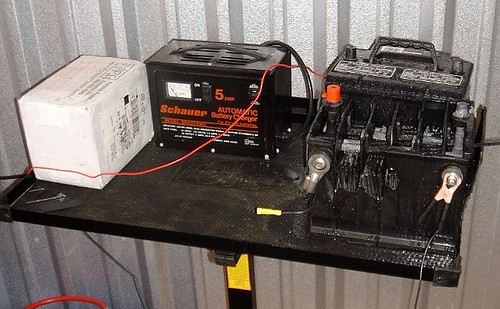Okay so this is the first time I've experienced a dead battery in my Cessna 150L. It has been sitting for a month at the airport because the airport was closed for runway resurfacing. Yesterday I went to fly it and the battery just didn't have enough juice to power the starter. I know, I should have gone out there and ran it up at least once during June, but I didn't 
Anyway I got a jump from the linemen and took a short 10 minute flight to a neighboring airport where I will remain based while the rest of the construction at my home base is completed (They opened up the runway for a few days so basically this weekend was my only window of opportunity).
All-in-all the battery probably had about 20 minutes of charge time between the run-up, the linemen trying to figure out how to put the battery box cap back on, the taxi, and the flight.
After reaching my destination I tried restarting to see if the battery had been sufficiently charged enough (the volt meter returned to 0 after only a few minutes, initially). It did crank a few times but not enough to get it going.
I've had similar issues with car batteries, even with a healthy generator/alternator if the battery is allowed to completely run dry it "feels as if" cells are just dead and it will never return to it's original power potential. I'm not a battery expert so I don't know if that's what is going on all I can say is that is how batteries seem to behave (in my experience)
So, I'm probably looking at a battery replacement. But maybe it just needs more acid or maybe I should have charged it longer.
As far as a replacement my initial Googling brought up this for $200.
So here are my questions for those of you who are more knowledgeable in this area:
1) It is a 12 volt battery so it should be okay to jump it to a car (that's essentially what the linemen did). Could I attempt to charge the battery using a running car and a pair of jumper cables (not to jump the plane, start the plane, and charge using the plane's alternator but rather keep the plane off and charge using the car). If so, would I want to have the battery switch off or on during this charging?
2) Since it is a 12 volt battery, why is it that I can't just replace it with a run-of-the-mill car battery?
3) Could the existing battery be made to work properly again by adding acid, if so how do I go about doing that (I've never done that before) and how can I be sure I buy the right stuff?
4) Is there another option I'm overlooking?
Thank you in advance
Anyway I got a jump from the linemen and took a short 10 minute flight to a neighboring airport where I will remain based while the rest of the construction at my home base is completed (They opened up the runway for a few days so basically this weekend was my only window of opportunity).
All-in-all the battery probably had about 20 minutes of charge time between the run-up, the linemen trying to figure out how to put the battery box cap back on, the taxi, and the flight.
After reaching my destination I tried restarting to see if the battery had been sufficiently charged enough (the volt meter returned to 0 after only a few minutes, initially). It did crank a few times but not enough to get it going.
I've had similar issues with car batteries, even with a healthy generator/alternator if the battery is allowed to completely run dry it "feels as if" cells are just dead and it will never return to it's original power potential. I'm not a battery expert so I don't know if that's what is going on all I can say is that is how batteries seem to behave (in my experience)
So, I'm probably looking at a battery replacement. But maybe it just needs more acid or maybe I should have charged it longer.
As far as a replacement my initial Googling brought up this for $200.
So here are my questions for those of you who are more knowledgeable in this area:
1) It is a 12 volt battery so it should be okay to jump it to a car (that's essentially what the linemen did). Could I attempt to charge the battery using a running car and a pair of jumper cables (not to jump the plane, start the plane, and charge using the plane's alternator but rather keep the plane off and charge using the car). If so, would I want to have the battery switch off or on during this charging?
2) Since it is a 12 volt battery, why is it that I can't just replace it with a run-of-the-mill car battery?
3) Could the existing battery be made to work properly again by adding acid, if so how do I go about doing that (I've never done that before) and how can I be sure I buy the right stuff?
4) Is there another option I'm overlooking?
Thank you in advance



